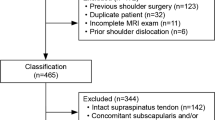Abstract
Supraspinatus tendon tears are complex yet common. We have shown that the supraspinatus and infraspinatus tendons interact, indicated by parallel changes in strain in the supraspinatus and infraspinatus with increasing size of supraspinatus tear, load applied to the supraspinatus, and changes in glenohumeral rotation but not abduction angle, suggesting disruption in the interaction between the two tendons with increase in abduction angle. While considering these factors individually is valuable, the contribution of each factor in the context of all others on strain in the supraspinatus, or on the interaction between the two tendons is unknown and has important implications in the management of rotator cuff tears. In this study, regression models using least-square estimation with backward and forward elimination were used to predict strains in the infraspinatus and supraspinatus from joint position, supraspinatus load, and supraspinatus tear size or repair. Interestingly, despite previous findings showing that supraspinatus tear size significantly affects infraspinatus strain, tear size was not a significant predictor of infraspinatus strain, emphasizing the importance of other factors evaluated such as joint position and shoulder loading in management of cuff tears and postoperative care. A better understanding of the loading environment in rotator cuff tendons necessitates multifactorial complex models.


Similar content being viewed by others
References
Andarawis-Puri, N., A. F. Kuntz, S.-Y. Kim, and L. J. Soslowsky. Effect of anterior supraspinatus tendon partial-thickness tears on infraspinatus tendon strain through a range of joint rotation angles. J. Shoulder Elbow Surg., in print, 2009. PMID: 20080051.
Andarawis-Puri, N., A. F. Kuntz, M. L. Ramsey, and L. J. Soslowsky. Effect of glenohumeral abduction angle on the mechanical interaction between the supraspinatus and infraspinatus tendons for the intact, partial-thickness torn and repaired supraspinatus tendon conditions. J. Orthop. Res., in print, 2009. PMID: 20058264.
Andarawis-Puri, N., E. T. Ricchetti, and L. J. Soslowsky. Interaction between the supraspinatus and infraspinatus tendons: effect of anterior supraspinatus tendon full-thickness tears on infraspinatus tendon strain. Am. J. Sports Med. 37(9):1831–1839, 2009.
Bey, M. J., M. L. Ramsey, and L. J. Soslowsky. Intratendinous strain fields of the supraspinatus tendon: effect of a surgically created articular-surface rotator cuff tear. J. Shoulder Elbow Surg. 11(6):562–569, 2002.
Bey, M. J., H. K. Song, F. W. Wehrli, and L. J. Soslowsky. Intratendinous strain fields of the intact supraspinatus tendon: the effect of glenohumeral joint position and tendon region. J. Orthop. Res. 20(4):869–874, 2002.
Breazeale, N. M., and E. V. Craig. Partial-thickness rotator cuff tears. Pathogenesis and treatment. Orthop. Clin. North Am. 28(2):145–155, 1997.
Fukuda, H. Partial-thickness rotator cuff tears: a modern view on Codman’s classic. J. Shoulder Elbow Surg. 9(2):163–168, 2000.
Fukuda, H., K. Hamada, T. Nakajima, and A. Tomonaga. Pathology and pathogenesis of the intratendinous tearing of the rotator cuff viewed from en bloc histologic sections. Clin. Orthop. Relat. Res. 304:60–67, 1994.
Fukuda, H., K. Hamada, and K. Yamanaka. Pathology and pathogenesis of bursal-side rotator cuff tears viewed from en bloc histologic sections. Clin. Orthop. Relat. Res. 254:75–80, 1990.
Neter, J., M. H. Kutner, C. J. Nachtsheim, and W. Wasserman. Building the regression model I: selection of predictor variables. In: Applied Linear Statistical Models, 4th edn. New York, NY: Irwin, pp. 327–355, 1996.
Neter, J., M. H. Kutner, C. J. Nachtsheim, and W. Wasserman. Table B.7 Durbin Watson test bounds. In: Applied Linear Statistical Models, 4th edn. New York, NY: Irwin, p. 1349, 1996.
Reilly, P., A. A. Amis, A. L. Wallace, and R. J. Emery. Supraspinatus tears: propagation and strain alteration. J. Shoulder Elbow Surg. 12(2):134–138, 2003.
Acknowledgments
This study was supported by a grant from the NIH/NIAMS (AR050176) and the NIH/NIAMS supported Penn Center for Musculoskeletal Disorders (AR050950). We thank Arthrex for providing the suture anchors.
Author information
Authors and Affiliations
Corresponding author
Additional information
Associate Editor Eric M. Darling oversaw the review of this article.
Rights and permissions
About this article
Cite this article
Andarawis-Puri, N., Kuntz, A.F., Jawad, A.F. et al. Infraspinatus and Supraspinatus Tendon Strain Explained Using Multiple Regression Models. Ann Biomed Eng 38, 2979–2987 (2010). https://doi.org/10.1007/s10439-010-0056-9
Received:
Accepted:
Published:
Issue Date:
DOI: https://doi.org/10.1007/s10439-010-0056-9




